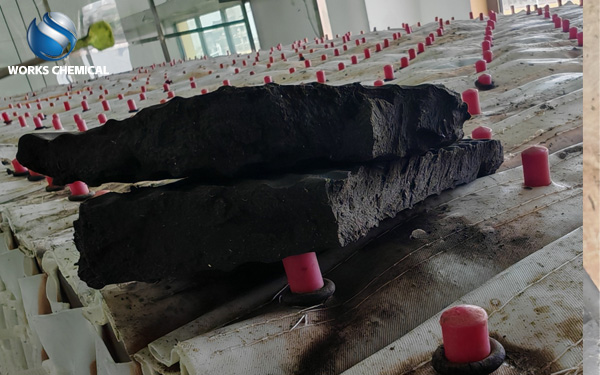
Papermaking sludge contains a lot of cellulose organic matter, nitrogen, phosphorus and potassium and other plant nutrients, the ash content is large, generally up to 50%-70%, the water content is as high as 95%, and it remains at 60%-80% after dehydration, and contains pathogenic bacteria, and the calorific value is low. In view of these characteristics of paper sludge, the selection of the appropriate sludge conditioner needs to consider a number of factors, the following are some specific recommendations:

First, understanding the properties of sludge
Organic matter content: The sludge with high organic matter content is suitable for selecting cationic organic polymer adjuster, and the higher the organic matter content, the more suitable for choosing cationic organic polymer adjuster with higher polymerization degree.Sludge particle size: fine sludge particles will lead to an increase in the consumption of conditioner. Therefore, when selecting sludge conditioner, it is necessary to consider the influence of sludge particle size on the conditioning effect.
Solid content of sludge: The higher the solid content of sludge, the larger the dosage of conditioner is usually. When selecting the sludge conditioner, it is necessary to determine the appropriate dosage according to the solid content of the sludge.
Sludge pH value: The pH value of sludge has an important influence on the form of hydrolyzed products of inorganic salt conditioners. For example, the hydrolysis reaction of aluminum salt is greatly affected by pH value, and the optimal pH value of its condensation reaction is 5-7; Ferric salt conditioner is less affected by pH value, and the optimal pH value range is 6-11. Therefore, when selecting inorganic salt adjusters, it is necessary to consider whether the pH value of the sludge is suitable for the use of the selected sludge adjusters.
Two, consider the sludge treatment process
Dehydration method: Different dehydration methods (such as vacuum filtration, plate and frame press filtration, centrifugal dehydration, etc.) have different requirements for conditioners. For example, when using vacuum filter and plate and frame filter press to dehydrate sludge, inorganic conditioner can be considered; When using centrifugal dewatering machine and belt filter press to dewater sludge, it is more suitable to use organic conditioner.Equipment compatibility: When selecting the conditioner, it is necessary to consider its compatibility with existing sludge treatment equipment. For example, certain conditioners may clog the filter cloth or affect the normal operation of the equipment, so you need to avoid choosing such conditioners.
Three. Evaluation of cost-effectiveness
Pharmaceutical cost: Different types of conditioners have different prices, and it is necessary to choose the right conditioner according to the actual demand and budget. At the same time, it is also necessary to consider the effect of the dosage of the drug on the cost.
Operating costs: In addition to pharmaceutical costs, it is also necessary to consider the impact of operating costs (such as electricity, manpower, equipment maintenance, etc.) on the overall cost. For example, some conditioners may require special dissolution or dosing equipment, which increases operating costs.
Four, pay attention to environmental protection requirementsChoosing environmentally friendly sludge conditioner can reduce the pollution to the environment. For example, some organic polymer conditioners have good biodegradability and will not cause secondary pollution to the water body. At the same time, it is also necessary to consider the environmental impact of the sludge conditioner during production, use and disposal.
Five, common sludge conditioner types
Inorganic conditioner: such as lime, aluminum hydroxide, iron hydroxide, etc., by neutralizing the organic acids in the sludge and adjusting the pH value of the sludge to improve the dewatering performance of the sludge. The advantages of inorganic conditioner are low cost and good dehydration effect, but the addition amount is large, which may lead to an increase in the amount of sludge after treatment.
Acid and base conditioner: By changing the pH value of the sludge, the colloids and suspended matter in the sludge condense to form larger particles, and improve the dewatering performance of the sludge. Common acid-base conditioners are lime, sodium hydroxide, sulfuric acid and so on.
Biological conditioner: microbial based sludge treatment technology, by decomposing the organic matter in the sludge, improve the dewatering performance of the sludge.
Flocculant: can promote the small particles in the sludge to aggregate into larger flocculent, improve the dewatering performance of the sludge. Common flocculants are polyaluminum chloride (PAC), polyacrylamide (PAM, including cationic, anionic and non-ionic) and so on.
Sludge dewatering agent: a chemical specially used to improve the dewatering performance of sludge, with the advantages of less dosage, low cost, good treatment effect and so on. Widely used in life, printing and dyeing, paper making, electroplating, chemical industry, leather and other industries of sludge dewatering disposal.
In summary, the selection of suitable sludge conditioner for papermaking sludge requires comprehensive consideration of many factors such as sludge properties, treatment technology, cost effectiveness and environmental protection requirements. By comprehensively evaluating these factors, the sludge conditioning program most suitable for the industry can be developed.